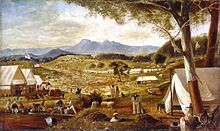Australian gold rushes

Gold diggings, Ararat, Victoria, by , 1854
|
|
| Duration | Australia |
|---|---|
| Date | May 1851 |
| Type | Gold rush |
| Theme | Significant numbers of workers (both from other areas within Australia and from overseas) relocated to areas in which gold had been discovered |
| Cause | prospector Edward Hargraves claimed to have discovered payable gold near Orange |
| Outcome | Changed the convict colonies into more progressive cities with the influx of free emigrants |
During the Australian gold rushes, significant numbers of workers (both from other areas within Australia and from overseas) relocated to areas in which gold had been discovered. A number of gold finds occurred in Australia prior to 1851, but only the gold found from 1851 onwards created gold rushes. This is mainly because, prior to 1851, the colonial government of New South Wales (Victoria did not become a separate colony until 1 July 1851) had suppressed news of gold finds which it believed would reduce the workforce and destabilise the economy.
After the California gold rush began in 1848, which caused many people to leave Australia for California to look for gold there, the New South Wales government rethought its position, and sought approval from the Colonial Office in England to allow the exploitation of the mineral resources and also offered rewards for the finding of payable gold.
The first gold rush in Australia began in May 1851 after prospector Edward Hargraves claimed to have discovered payable gold near Orange, at a site he called Ophir. Hargraves had been to the Californian goldfields and had learned new gold prospecting techniques such as panning and cradling. Hargraves was offered rewards by the Colony of New South Wales and the Colony of Victoria. Before the end of the year, the gold rush had spread to many other parts of the state where gold had been found, not just to the west, but also to the south and north of Sydney.
The Australian gold rushes changed the convict colonies into more progressive cities with the influx of free emigrants. These hopefuls, termed diggers, brought new skills and professions, contributing to a burgeoning economy. The mateship that evolved between these diggers and their collective resistance to authority led to the emergence of a unique national identity. Although not all diggers found riches on the goldfields, many decided to stay and integrate into these communities.
...
Wikipedia
